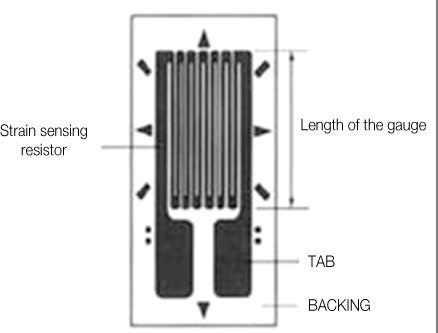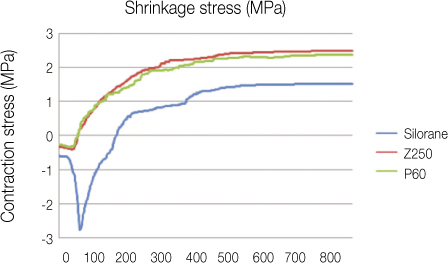J Korean Acad Conserv Dent.
2011 May;36(3):188-195. 10.5395/JKACD.2011.36.3.188.
Evaluation of polymerization shrinkage stress in silorane-based composites
- Affiliations
-
- 1Department of Conservative Dentistry, Chosun University School of Dentistry, Gwangju, Korea. minjb@chosun.ac.kr
- KMID: 1986682
- DOI: http://doi.org/10.5395/JKACD.2011.36.3.188
Abstract
OBJECTIVES
The purpose of this study was to evaluate the polymerization shrinkage stress among conventional methacrylate-based composite resins and a silorane-based composite resin.
MATERIALS AND METHODS
The strain gauge method was used for the determination of polymerization shrinkage strain. Specimens were divided by 3 groups according to various composite materials. Filtek Z-250 (3M ESPE) and Filtek P-60 (3M ESPE) were used as a conventional methacrylate-based composites and Filtek P-90 (3M ESPE) was used as a silorane-based composites. Measurements were recorded at each 1 second for the total of 800 seconds including the periods of light application. The results of polymerization shrinkage stress were statistically analyzed using One way ANOVA and Tukey test (p = 0.05).
RESULTS
The polymerization shrinkage stress of a silorane-based composite resin was lower than those of conventional methacrylate-based composite resins (p < 0.05). The shrinkage stress between methacrylate-based composite resin groups did not show significant difference (p > 0.05).
CONCLUSIONS
Within the limitation of this study, silorane-based composites showed lower polymerization shrinkage stress than methacrylate-based composites. We need to investigate more into polymerization shrinkage stress with regard to elastic modulus of silorane-based composites for the precise result.
MeSH Terms
Figure
Cited by 1 articles
-
Microtensile bond strength of silorane-based composite specific adhesive system using different bonding strategies
Laura Alves Bastos, Ana Beatriz Silva Sousa, Brahim Drubi-Filho, Fernanda de Carvalho Panzeri Pires-de-Souza, Lucas da Fonseca Roberti Garcia
Restor Dent Endod. 2015;40(1):23-29. doi: 10.5395/rde.2015.40.1.23.
Reference
-
1. Kwon YC, Lee IB. Polymerization shringage of kinetics of silorane-based composites. J Korean Acad Conserv Dent. 2010. 35:51–58.
Article2. Peutzfeldt A. Resin composites in dentistry: the monomer systems. Eur J Oral Sci. 1997. 105:97–116.
Article3. Braga RR, Ferracane FL. Alternatives in polymerization contraction stress management. Crit Rev Oral Biol Med. 2004. 15:176–184.
Article4. Davidson CL, Feilzer AJ. Polymerization shrinkage and polymerization shrinkage stress in polymer-based restoratives. J Dent. 1997. 25:435–440.
Article5. Kleverlaan CJ, Feilzer AJ. Polymerization shrinkage and contraction stress of dental resin composites. Dent Mater. 2005. 21:1150–1157.
Article6. Song YX, Inoue K. Linear shrinkage of photo-activated composite resins during setting. J Oral Rehabil. 2001. 28:335–341.
Article7. Lee IB, Cho BH, Son HH, Um CM. A new method to measure the polymerization shrinkage kinetics of light cured composites. J Oral Rehabil. 2005. 32:304–314.
Article8. Dauvillier BS, Aarnts MP, Feilzer AJ. Developments in shrinkage control of adhesive restoratives. J Esthet Dent. 2000. 12:291–299.
Article9. Carvalho RM, Pereira JC, Yoshiyama M, Pashley DH. A review of polymerization contraction: the influence of stress development versus stress relief. Oper Dent. 1996. 21:17–24.10. Park J, Chang J, Ferracane J, Lee IB. How should composite be layered to reduce shrinkage stress: incremental or bulk filling? Dent Mater. 2008. 24:1501–1505.
Article11. Lee MR, Cho BH, Son HH, Um CM, Lee IB. Influence of cavity dimension and restoration methods on the cusp deflection of premolars in composite restoration. Dent Mater. 2007. 23:288–295.
Article12. Weinmann W, Thalacker C, Guggenberg R. Siloranes in dental composites. Dent Mater. 2005. 21:68–74.
Article13. Stansbury JW, Trujillo-Lemon M, Lu H, Ding X, Lin Y, Ge J. Conversion-dependent shrinkage stress and strain in dental resins and composites. Dent Mater. 2005. 21:56–67.
Article14. Papadogiannis D, Kakaboura A, Palaghias G, Eliades G. Setting characteristics and cavity adaptation of low-shrinking resin composites. Dent Mater. 2009. 25:1509–1516.
Article15. Miletic V, Ivanovic V, Dzeletovic B, Lezaja M. Temperature changes in Silorane-, Ormocer-, and Dimethacrylate-based composites and pulp chamber roof during light-curing. J Esthet Restor Dent. 2009. 21:122–132.
Article16. Palin WM, Fleming GJP, Nathwani H, Burke FJT, Randall RC. in vitro cuspal deflection and microleakage of maxillary premolars restored with novel low-hrink dental composites. Dent Mater. 2005. 21:324–335.
Article17. Sakaguchi RL, Sasik CT, Bunczak MA. Strain gauge method for measuring polymerization contraction of composite restoratives. J Dent. 1991. 19:312–316.
Article18. Sakaguchi RL, Douglas WH. Strain gauge measurement of polymerization shrinkage. J Dent Res. 1989. 68:977.19. Sakaguchi RL, Douglas WH, Peters MC. Curing light performance and polymerization fo composite restorative materials. J Dent. 1992. 20:183–188.
Article20. Lindeburg MR. Civil engineering reference manual. 1989. 5th ed. Belmont, CA: Professional;12–27.21. Peutzfeldt A. Resin composites in dentistry: the monomer systems. Eur J Oral Sci. 1997. 105:97–116.
Article22. Chappelow CC, Pinzino CS, Power MD, Eick JD. Photocured epoxy/SOC matrix resin systems for dental composites. Polymer Reprints. 1997. 38:90–91.23. Cadenaro M, Biasotto M, Scuor N, Breschi L, Davidson CL, Lenarda R. Assessment of polymerization contraction stress of three composite resins. Dent Mater. 2008. 24:681–685.
Article24. Braga RR, Hilton TJ, Ferracane JL. Contraction stress of flowable composite materials and their efficacy as stress-relieving layers. J Am Dent Assoc. 2003. 134:721–728.
Article25. Seo DG, Min SH, Lee IB. Effect of instrument compliance on the polymerization shrinkage stress measurements of dental resin composites. J Korean Acad Conserv Dent. 2009. 34:145–153.
Article26. Boaro LC, Gonçalves F, Guimarães TC, Ferracane JL, Versluis A, Braga RR. Polymerization stress, shrinkage and elastic modulus of current low-shrinkage restorative composites. Dent Mater. 2010. 26:1144–1150.
Article27. Condon JR, Ferracane JL. Assessing the effect of composite formulation on polymerization stress. J Am Dent Assoc. 2000. 131:497–503.
Article28. Watts DC, Vogel K, Marouf AS. Shrinkage stress reduction in resin-composites of increasing particle concentration. J Dent Res. 2002. 81(Special Issue A):308. Abstract #2444.29. Obici AC, Sinhoreti MAC, de Goes MF, Consai S, Sobrinho LC. Effect of the photo-activation method on polymerization shrinkage of restorative composites. Oper Dent. 2002. 27:192–198.30. Ferracane JL. Developing a more complete understanding of stresses produced in dental composites during polymerization. Dent Mater. 2005. 21:36–42.
Article
- Full Text Links
- Actions
-
Cited
- CITED
-
- Close
- Share
- Similar articles
-
- Polymerization shrinkage kinetics of silorane-based composites
- A new method to measure the linear polymerization shrinkage of composites using a particle tracking method with computer vision
- Measurements of shrinkage stress and reduction of inter-cuspal distance in maxillary premolars resulting from polymerization of composites and compomers
- Amount of polymerization shrinkage and shrinkage stress in composites and compomers for posterior restoration
- The effect of resin thickness on polymerization characteristics of silorane-based composite resin





